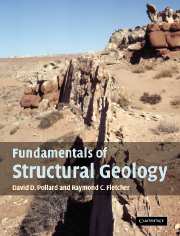Chapter 2 - Structural mapping techniques and tools
Summary
Structural geologists use a GPS receiver to determine the UTM coordinates of the point under their feet on this outcrop of Aztec sandstone in the Valley of Fire, NV. Photograph by D.D. Pollard.
‘You think these raindrops are random?’ his uncle had asked. And Leaphorn had been surprised. He'd said of course they were random. Didn't his uncle think they were random?
‘The stars,’ Haskie Jim said. ‘We have a legend about how First Man and First Woman, over by Huerfano Mesa, had the stars in their blanket and were placing them carefully in the sky. And then Coyote grabbed the blanket and whirled it around and flung them into the darkness and that is how the Milky Way was formed. Thus order in the sky became chaos. Random. But even then … Even then, what Coyote did was evil, but was there not a pattern, too, in the evil deed?’
That had not been the time in Leaphorn's life when he had patience for the old metaphysics. He remembered telling Haskie Jim about modern astronomy and the cosmic mechanics of gravity and velocity. Leaphorn had said something like ‘Even so, you couldn't expect to find anything except randomness in the way the rain fell.’ And Haskie Jim had watched the rain awhile, silently. And then he had said, and Joe Leaphorn still remembered not just the words but the old man's face when he said them: ‘I think from where we stand the rain seems random.
- Type
- Chapter
- Information
- Fundamentals of Structural Geology , pp. 25 - 74Publisher: Cambridge University PressPrint publication year: 2005



